Physical Address
Minuwangoda ,Sri Lanka.
Physical Address
Minuwangoda ,Sri Lanka.

Raven tattoos are rich in meaning and symbolism, drawing from mythology, literature, and various cultural references. Whether you are considering getting a raven tattoo or are simply curious about the fascinating significance behind these designs, this article will provide you with an in-depth look at what raven tattoos represent, their historical and cultural significance, and tips on choosing the perfect raven tattoo for you.
Raven tattoos are more than just a striking visual choice; they are steeped in rich symbolism and deep meanings that can resonate with the wearer on multiple levels. These tattoos often reflect themes of mystery, intelligence, transformation, and the duality of life and death.
Ravens are often associated with mystery and the unknown, due in part to their dark plumage and their role in various mythologies as messengers or omens. A raven tattoo can symbolize an individual’s intrigue with the mysterious aspects of life or their comfort with the unknown. It may represent a person’s journey into the depths of their psyche or their exploration of spiritual or esoteric realms.
Ravens are highly intelligent birds, known for their problem-solving abilities and complex social interactions. They have been observed using tools, solving puzzles, and exhibiting behaviours that suggest a high level of cognitive function. A raven tattoo can embody the wearer’s own intelligence, cleverness, and adaptability. It may serve as a reminder of the importance of wisdom and the pursuit of knowledge in one’s life.
Ravens are often seen as symbols of transformation and change. In nature, they play a role in the cycle of life and death, often being found near carcasses and acting as scavengers that clean up the environment. This aspect of the raven can symbolize the wearer’s acceptance of change and their ability to adapt to new circumstances. A raven tattoo can represent a personal transformation or a significant change in one’s life, marking a period of growth and renewal.
Ravens are frequently linked to themes of life and death, partly due to their black colour and their association with the afterlife in various cultures. They are often seen as messengers between the living and the dead, representing the thin veil that separates these two realms. A raven tattoo can embody the duality of existence, acknowledging the inevitability of death while celebrating the vibrancy of life. It can serve as a powerful reminder to live fully and embrace each moment.
Ravens hold significant spiritual and mythological roles in many cultures. In Norse mythology, Odin’s ravens, Huginn and Muninn, symbolize thought and memory, travelling the world to bring back information to the god. In Native American traditions, ravens are often seen as tricksters and creators, embodying the balance between light and dark. In Celtic mythology, ravens are linked to the Morrigan, a goddess of battle and prophecy. A raven tattoo can signify the wearer’s connection to these spiritual beliefs or their reverence for the myths and legends that feature these enigmatic birds.
In some cultures, ravens are seen as protectors or guides. They are believed to have the ability to ward off evil spirits or provide guidance to those who have lost their way. A raven tattoo can be a symbol of protection, serving as a talisman to guard the wearer from harm. It can also represent guidance, suggesting that the wearer is open to receiving direction and support from spiritual or supernatural sources.
For many, a raven tattoo is a deeply personal symbol that reflects their identity and sense of empowerment. It can represent an individual’s strength, resilience, and independence. Ravens are known for their boldness and ability to thrive in diverse environments, which can be a powerful metaphor for someone who has overcome challenges and emerged stronger. A raven tattoo can be a celebration of one’s unique journey and a declaration of their inner power.
In conclusion, raven tattoos carry a multitude of meanings, each layer adding depth to the significance of the design. Whether you are drawn to the raven for its mysterious allure, its intellectual symbolism, its representation of transformation, or its mythological connections, a raven tattoo can be a profound and meaningful choice that resonates with your personal story and values.
Raven birds are profound symbols across various cultures and traditions, often embodying a rich tapestry of meanings. Their dark plumage, intelligent behaviour, and notable presence in mythologies contribute to their deep and multifaceted symbolism. Here, we delve into the various interpretations and significances that ravens hold around the world.
Ravens are renowned for their remarkable intelligence and cunning. These birds have demonstrated sophisticated problem-solving skills, tool use, and an ability to learn from and mimic human behaviours. Because of this, ravens are often seen as symbols of intellect, wisdom, and cleverness. In many cultures, having a raven as a totem animal signifies that one possesses a sharp mind, keen observation skills, and an ability to adapt and thrive in diverse situations.
Ravens are frequently associated with transformation and change. In nature, they play a pivotal role in the cycle of life and death, acting as scavengers that help decompose dead animals and recycle nutrients back into the ecosystem. This role situates ravens as symbols of transformation, renewal, and the continuous cycle of life. A raven’s presence can symbolize the end of one phase and the beginning of another, marking significant transitions and personal growth.
Across various mythologies and cultures, ravens are seen as messengers and omens. Their presence is often interpreted as a sign or a communication from the spiritual world. In Norse mythology, Odin’s ravens, Huginn (thought) and Muninn (memory), fly across the world to gather information and bring it back to their master, signifying the raven’s role as a messenger of the gods. Similarly, in Native American traditions, ravens are seen as intermediaries between the earthly realm and the spirit world, conveying important messages and guiding souls.
The raven’s dark plumage and frequent presence near battlefields and sites of death have contributed to its association with death and the afterlife. In many cultures, ravens are seen as psychopomps, creatures that guide souls to the afterlife. For instance, in Celtic mythology, the raven is linked to the Morrigan, a goddess of battle and death who can transform into a raven. This connection with death does not necessarily signify something negative; rather, it underscores the raven’s role in the natural cycle and the continuation of life beyond death.
Ravens are often considered mystical and mysterious creatures, partly due to their black feathers and eerie calls. They are frequently depicted in folklore and literature as enigmatic beings with a connection to the supernatural. In Edgar Allan Poe’s famous poem “The Raven,” the bird represents the haunting presence of loss and the mystery of the unknown. This mysterious aura makes the raven a powerful symbol of the unknown, the hidden, and the mystical aspects of life.
Ravens hold significant roles in various cultural myths and legends:
Ravens embody the duality of light and dark, life and death. Their ability to traverse different realms—earthly, spiritual, and mythological—positions them as symbols of balance and the interconnection of opposites. This duality is reflected in the raven’s role as both a harbinger of doom and a symbol of insight and guidance.
In some traditions, ravens are seen as protectors. Their presence can ward off evil spirits and offer spiritual protection. This protective symbolism is often incorporated into raven tattoos or used as talismans to provide safety and guidance to individuals.
Inspired by the character from George R.R. Martin’s “Game of Thrones” series, a three-eyed raven tattoo signifies wisdom and foresight. The third eye is often associated with inner vision and enlightenment, suggesting that the wearer values insight and a deeper understanding of the world.
A black raven tattoo is a powerful symbol of mystery, intelligence, and the unknown. Black, as a colour, often represents the void and the mysteries that lie within it. A black raven can symbolize the depth of one’s thoughts and the complexity of their inner life.
“The Crow,” a cult film from the 1990s, uses the crow as a symbol of vengeance and redemption. The protagonist, Eric Draven, is brought back to life by a crow to avenge his and his fiancée’s deaths. A tattoo inspired by this film can symbolize justice, resurrection, and the power of love.
Ravens hold a prominent place in Native American mythology, often depicted as powerful and multifaceted figures. They are revered as creatures of great importance, embodying a range of attributes from tricksters to creators, and playing crucial roles in the spiritual and cultural narratives of various Native American tribes.
In many Native American traditions, the raven is seen as a trickster figure, similar to the coyote in other myths. Tricksters are characterized by their cunning, intelligence, and ability to cause both chaos and creation through their actions. Ravens in these myths often use their wit and cleverness to outsmart others, challenging the status quo and revealing deeper truths through their antics. These stories emphasize the raven’s role in teaching important life lessons, often through humorous or unexpected outcomes.
For example, in the mythology of the Haida people from the Pacific Northwest, Raven is a central character known for his mischievous and cunning behaviour. He is credited with creating the world and bringing light to humanity, often through trickery and cleverness. These stories portray Raven as both a benefactor and a deceiver, highlighting the dual nature of his character.
Ravens are also seen as creators and bringers of light in many Native American myths. They are credited with creating the world, shaping the landscape, and bringing essential elements like fire, light, and water to humanity. This aspect of the raven underscores its role as a symbol of transformation and the power to bring about significant change.
In the mythology of the Tlingit people, another tribe from the Pacific Northwest, Raven is depicted as a creator god who brought light to the world. According to legend, Raven stole the sun, moon, and stars from a powerful being and released them into the sky, thus illuminating the world. This act of bringing light symbolizes the raven’s role in overcoming darkness and ignorance, providing illumination and wisdom to humanity.
Ravens are often seen as spiritual messengers and guides in Native American culture. They are believed to possess the ability to travel between the physical and spiritual realms, carrying messages from the gods or ancestors. This role as an intermediary makes the raven a powerful symbol of communication and connection between different worlds.
In the beliefs of the Navajo, ravens are considered to be messengers of the gods, bringing important omens and guidance to the people. Their appearance is often interpreted as a sign or message from the spiritual realm, offering insight or warnings that can help individuals navigate their lives. This deep spiritual connection emphasizes the raven’s role as a bridge between the earthly and the divine.
Ravens are also associated with transformation and healing. Their scavenging behaviour, where they clean up the environment by consuming carrion, positions them as symbols of renewal and regeneration. This natural role is mirrored in their mythological significance, where they often bring about change and facilitate the healing process.
For the Kwakwaka’wakw people of the Pacific Northwest, the raven is a symbol of transformation and healing. In their ceremonial practices, the raven is invoked during healing rituals to aid in the process of transformation, helping individuals shed old patterns and embrace new ways of being. This association with healing underscores the raven’s ability to bring about positive change and renewal.
Different Native American tribes have their own unique interpretations and stories about ravens, reflecting the diverse cultures and beliefs across the continent. While the overarching themes of trickery, creation, and spiritual guidance are common, the specific stories and attributes of ravens can vary significantly.
For the Vikings, ravens were sacred birds associated with Odin, the Allfather. Odin had two ravens, Huginn and Muninn, who represented thought and memory. They would fly across the world and bring back information to Odin. A Viking raven tattoo can symbolize wisdom, knowledge, and a connection to Norse heritage.

In Celtic mythology, ravens are associated with warfare and the Morrigan, a goddess of battle and fate. The raven was believed to guide souls to the afterlife and serve as a symbol of protection and prophecy. A Celtic raven tattoo can embody these themes of protection, fate, and the warrior spirit.
Ravens in literature often symbolize death and the supernatural. Edgar Allan Poe’s famous poem “The Raven” features a raven as a harbinger of doom and a reminder of lost love. A literary-inspired raven tattoo can represent the power of words, the inevitability of death, and the haunting nature of grief.
When choosing a raven tattoo, consider the style that best fits your personality and the meaning you want to convey. Realistic, watercolour, tribal, and abstract designs are popular choices. The size and location of the tattoo can also impact its significance. Larger designs on the back or chest can make a bold statement, while smaller tattoos on the wrist or ankle can be more discreet.
Before getting a raven tattoo, research the artist’s portfolio to ensure they can execute the design you want. Consider the symbolism and personal significance of the tattoo, and be prepared for the commitment, as tattoos are permanent. Proper aftercare is crucial to ensure your tattoo heals well and retains its quality.
Yes, there are several species of raven, with the common raven (Corvus corax) being the most well-known. Different species of ravens can have slightly varying appearances and behaviours, but they all share the characteristic intelligence and adaptability of the corvid family.
Ravens are a part of the corvid family, which includes crows, magpies, and jays. While all ravens are corvids, not all corvids are ravens. Ravens are typically larger than crows, with thicker beaks and shaggier throat feathers. Their calls and behaviours also differ, with ravens being more solitary compared to the more social crows.
Corvids are often associated with intelligence, adaptability, and resourcefulness. Crows are seen as clever and communal, magpies as curious and playful, and jays as bold and vibrant. Each species has its own unique characteristics and cultural significance, making them fascinating subjects for tattoos.
Witchy and raven tattoos are a fascinating blend of mystical symbolism and artistic expression. These tattoos are often chosen by individuals who feel a strong connection to the mystical, the occult, and nature’s darker, more enigmatic aspects. They incorporate various elements of witchcraft, such as moons, stars, and magical symbols, alongside the iconic raven, to create a deeply personal and evocative piece of body art.
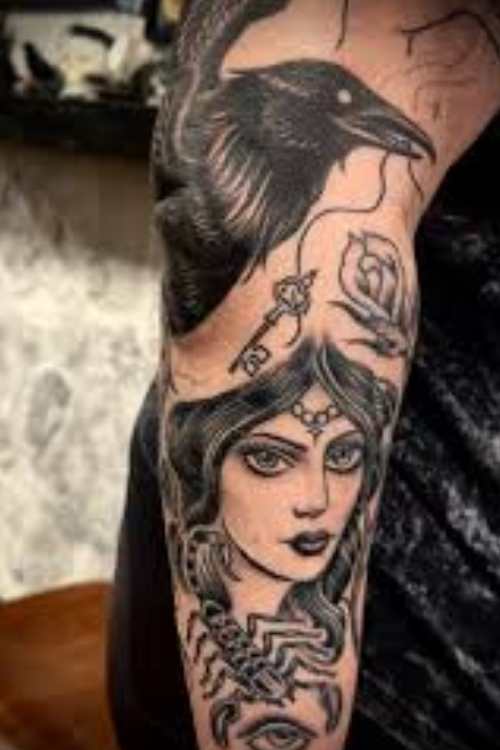
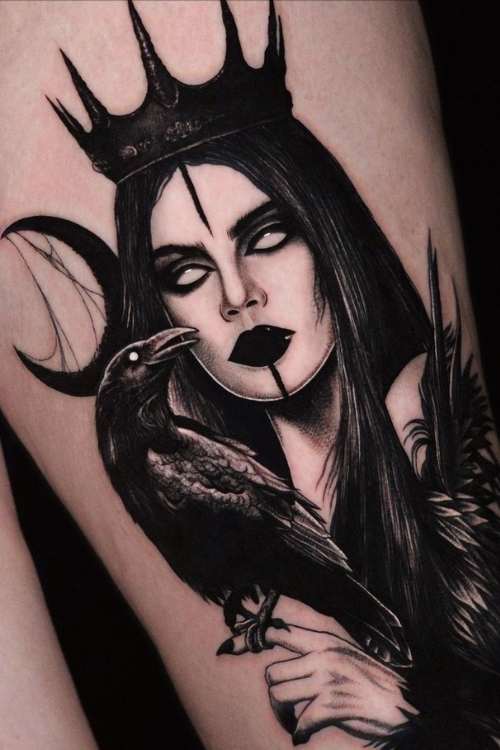
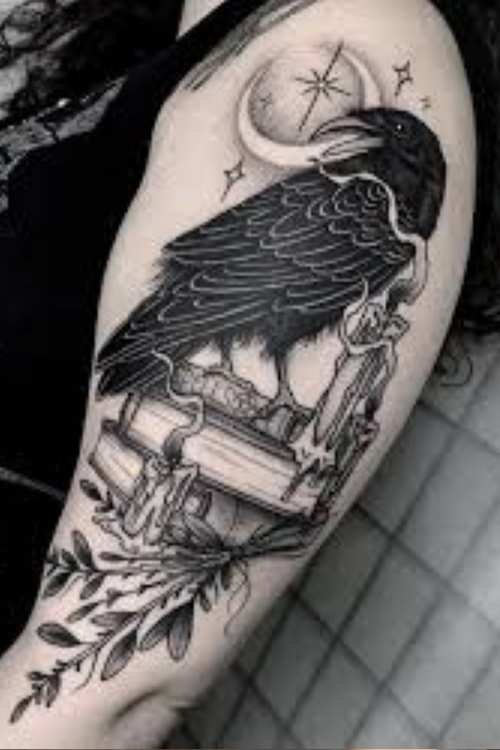
In the context of witchcraft, ravens are powerful symbols of mystery, magic, and the supernatural. Their association with the unknown and their role as messengers between worlds make them an ideal symbol for those who practice or are drawn to witchcraft.
Witchy raven tattoos often incorporate a variety of symbols and elements associated with witchcraft to enhance their mystical appeal and deepen their meaning. Some common elements include:
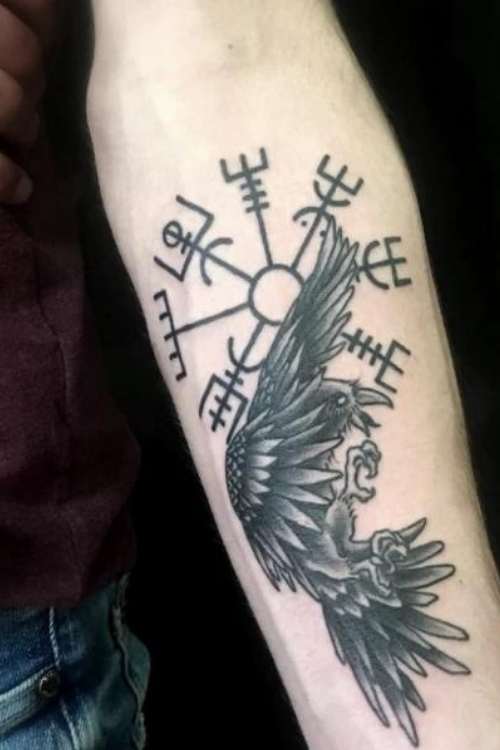
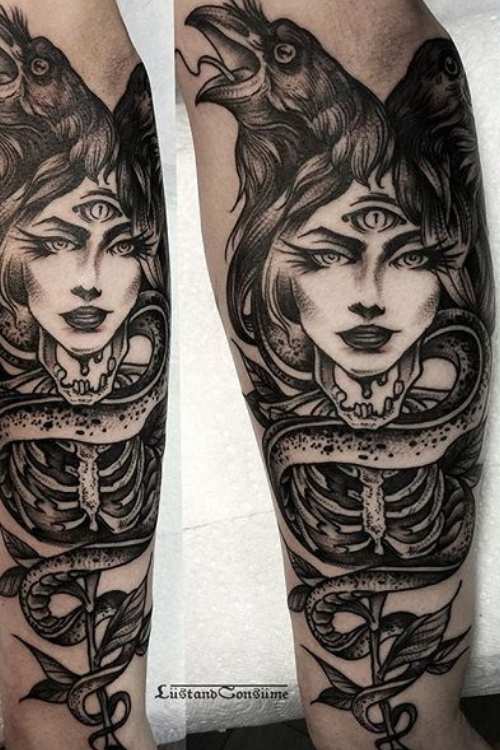
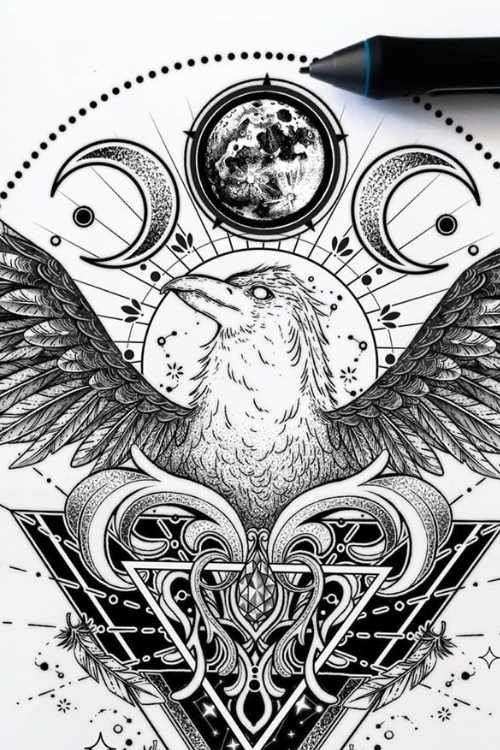
Witchy raven tattoos come in various styles, each adding a unique flavor to the tattoo’s overall meaning and appearance. Some popular styles include:
Witchy raven tattoos are not just about their visual appeal; they also carry deep personal significance for the wearer. These tattoos often reflect the individual’s spiritual journey, their connection to the mystical, and their sense of empowerment through their practice.
Before getting a witchy raven tattoo, there are a few important considerations to keep in mind:
Raven tattoos can symbolize a deep connection to nature and the wild. Ravens are highly adaptable birds found in diverse environments, representing resilience and the ability to thrive in various conditions. A nature-inspired raven tattoo can signify a love for the outdoors and a strong, independent spirit.
Ravens appear frequently in pop culture, from literature and movies to television shows and video games. Characters like the three-eyed raven from “Game of Thrones” and Eric Draven from “The Crow” have popularized raven tattoos. These influences can add layers of meaning and personal connection to your tattoo.
Raven tattoos can be a powerful symbol of personal empowerment and identity. They can represent overcoming challenges, embracing one’s inner strength, and acknowledging the complexity of the human experience. A raven tattoo can be a reminder of your resilience and unique journey.
Norse mythology is a rich tapestry of gods, heroes, and mythical creatures, with ravens playing a particularly significant role. Among the most iconic symbols in this tradition are Odin’s ravens, Huginn and Muninn. These mythological birds, along with other elements of Norse lore, make for deeply meaningful and visually striking tattoo designs. Let’s delve into the significance of Odin’s ravens and other aspects of Norse mythology that inspire tattoo enthusiasts.
Huginn and Muninn are two ravens that belong to Odin, the chief god in Norse mythology. Their names mean “thought” (Huginn) and “memory” (Muninn), reflecting their roles in Odin’s quest for knowledge.
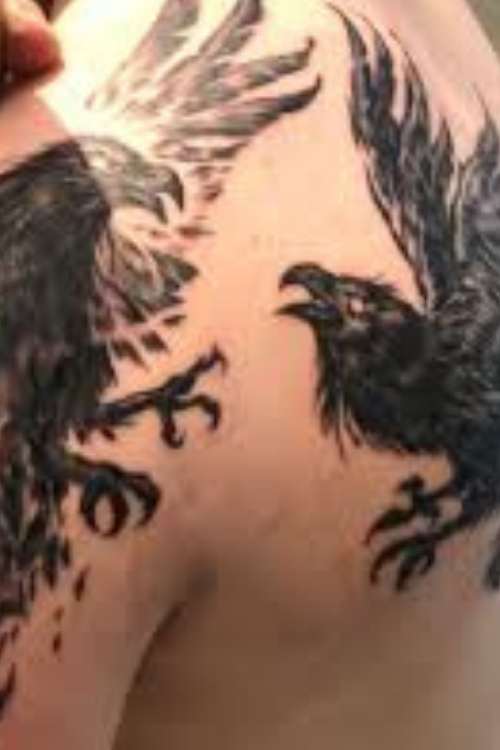
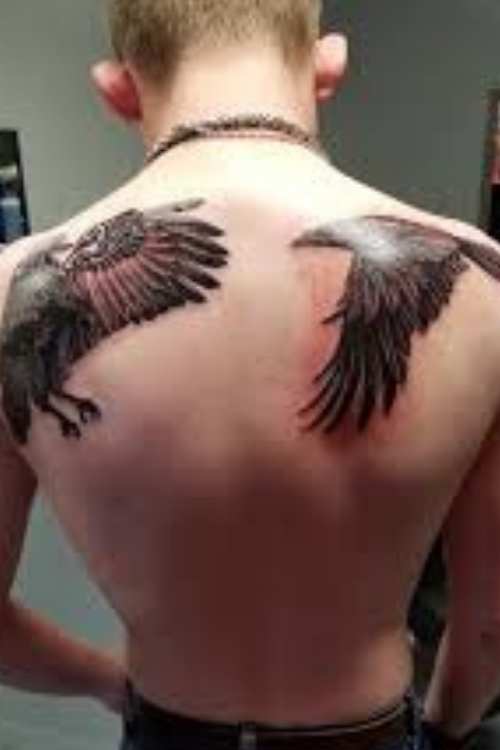
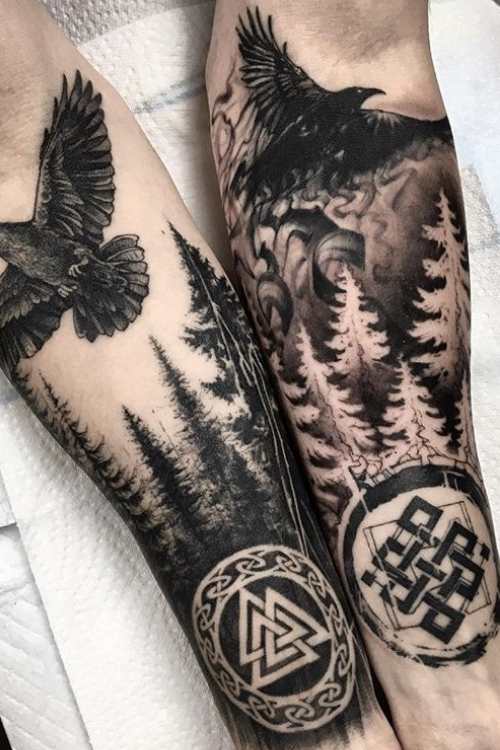
While Huginn and Muninn are the most famous ravens in Norse mythology, ravens in general hold significant symbolism throughout the mythos.
Combining ravens with other elements of Norse mythology can create a rich and complex tattoo design. Some popular elements include:
Norse raven tattoos can be designed in various styles, each bringing a different dimension to the symbolism.
Norse mythology tattoos, especially those featuring ravens, are not just about their striking appearance but also about the personal connection and empowerment they offer to the wearer.
Before committing to a Norse raven tattoo, there are several important considerations:
Raven tattoos are a popular choice for their deep symbolism and striking visual impact. Various designs have gained widespread recognition due to their artistic creativity, cultural significance, and association with famous personalities or works of literature and art. Here are some of the most famous and iconic raven tattoos:
One of the most famous associations with raven tattoos comes from Edgar Allan Poe’s poem “The Raven.” This dark, melancholic work has inspired countless tattoo designs that capture the poem’s haunting and mysterious essence.
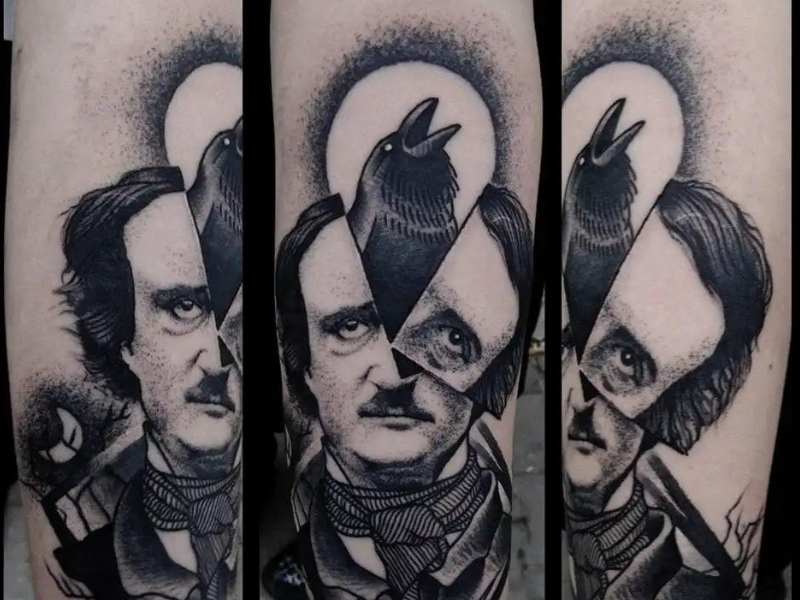
Odin’s ravens, Huginn (thought), and Muninn (memory) are central figures in Norse mythology. Their significance as Odin’s messengers and symbols of wisdom and memory make them popular choices for tattoos.



Ravens hold significant roles in various Native American cultures, often as tricksters, creators, and spiritual messengers. Tattoos inspired by these myths reflect deep cultural and spiritual meanings.
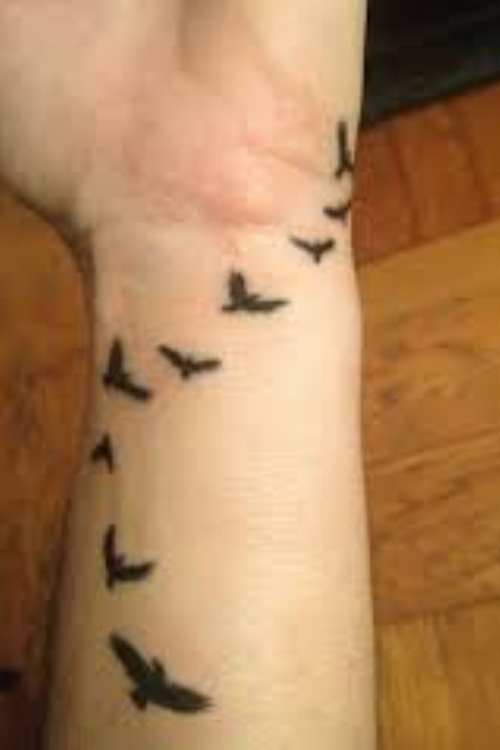
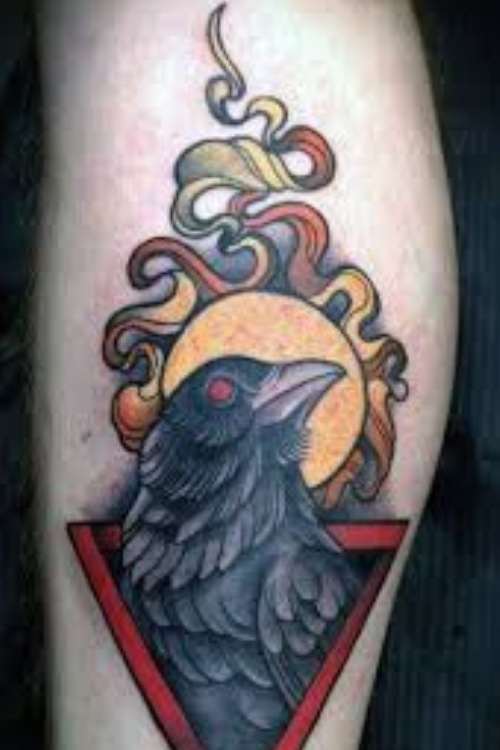
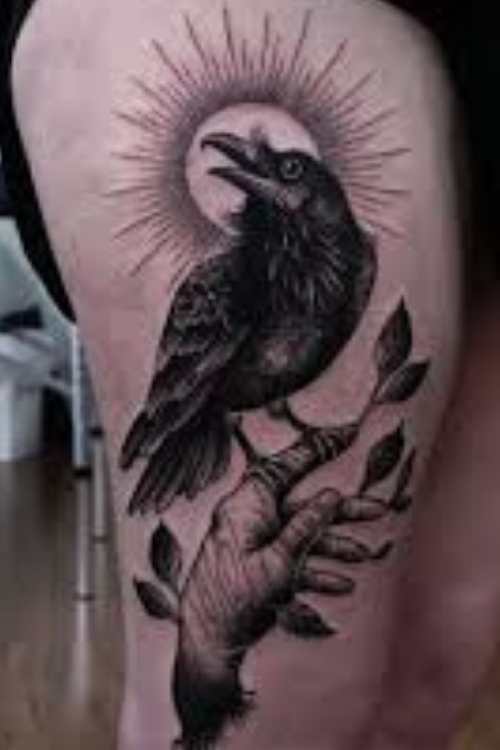
The 1994 film “The Crow,” based on the comic book series by James O’Barr, has popularized raven tattoos, particularly among fans of gothic and alternative subcultures.
Raven tattoos inspired by various works of literature and art reflect the bird’s enduring presence in the cultural imagination.
Several celebrities and public figures sport raven tattoos, adding to the bird’s popularity and iconic status.
Many famous raven tattoos are known for their intricate designs that combine the bird with other meaningful symbols.
1. What does a raven tattoo symbolize in different cultures?
2. How should I choose the style of my raven tattoo?
3. Where is the best location for a raven tattoo?
4. What should I know about the aftercare of a raven tattoo?
5. Can raven tattoos be combined with other symbols?
By understanding the deep meanings and cultural significance behind raven tattoos, you can make an informed decision that aligns with your personal values and aesthetic preferences. Whether you are drawn to the raven’s symbolism of intelligence and mystery or its connections to mythology and literature, a raven tattoo can be a powerful and meaningful addition to your body art collection.